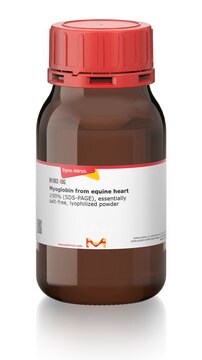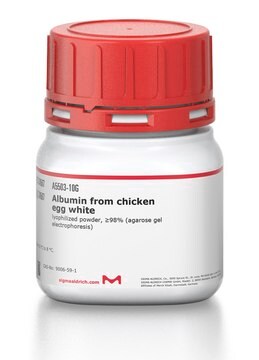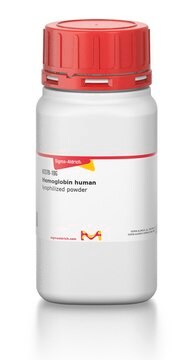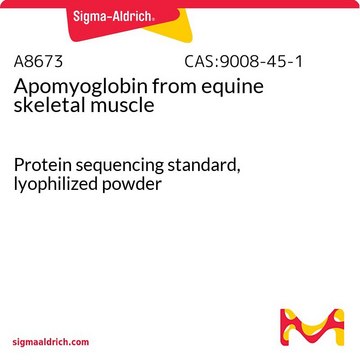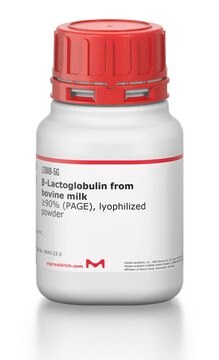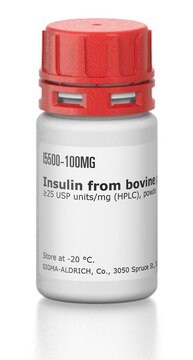M0630
Myoglobin from equine skeletal muscle
95-100%, essentially salt-free, lyophilized powder
Synonym(s):
Myoglobin from horse skeletal muscle
Sign Into View Organizational & Contract Pricing
All Photos(4)
About This Item
Recommended Products
biological source
equine skeletal muscle
Quality Level
Assay
95-100%
form
essentially salt-free, lyophilized powder
mol wt
~17 kDa(lit.)
Iron content
0.25-0.32%
technique(s)
mass spectrometry (MS): suitable
solubility
H2O: soluble 10 mg/mL
UniProt accession no.
storage temp.
−20°C
Gene Information
horse ... MB(100054434)
Looking for similar products? Visit Product Comparison Guide
Application
Myoglobin from equine skeletal muscle was used in a study to test experimental protein mixture for validating tandem mass spectral analysis.
Biochem/physiol Actions
Myoglobin from horse skeletal muscle is a single chain heme protein containing 153 amino acid residues. It possesses no disulfide bridges or free -SH groups. Myoglobin contains 8 variously sized right-handed helical regions, joined by non-ordered or random coil regions.
Myoglobin is critical to skeletal muscle O2 supply at near-maximum oxygen demand, and prevents anoxia by maintaining PO2 above levels needed to support mitochondrial function.
Storage Class Code
11 - Combustible Solids
WGK
WGK 3
Flash Point(F)
Not applicable
Flash Point(C)
Not applicable
Personal Protective Equipment
dust mask type N95 (US), Eyeshields, Gloves
Choose from one of the most recent versions:
Already Own This Product?
Find documentation for the products that you have recently purchased in the Document Library.
Customers Also Viewed
Anthony W Maresso et al.
PLoS pathogens, 4(8), e1000132-e1000132 (2008-08-30)
Acquisition of iron is necessary for the replication of nearly all bacterial pathogens; however, iron of vertebrate hosts is mostly sequestered by heme and bound to hemoglobin within red blood cells. In Bacillus anthracis, the spore-forming agent of anthrax, the
Emily S Choy et al.
The Journal of experimental biology, 222(Pt 11) (2019-05-18)
Arctic marine ecosystems are currently undergoing rapid environmental changes. Over the past 20 years, individual growth rates of beluga whales (Delphinapterus leucas) have declined, which may be a response to climate change; however, the scarcity of physiological data makes it difficult
Ru Fang et al.
Journal of nanobiotechnology, 9, 19-19 (2011-05-19)
The synthesis of bioactive nanoparticles with precise molecular level control is a major challenge in bionanotechnology. Understanding the nature of the interactions between the active components and transport biomaterials is thus essential for the rational formulation of bio-nanocarriers. The current
Y H Guan et al.
Journal of chromatography. A, 1217(21), 3525-3530 (2010-04-20)
Separation of large bioactive molecules such as proteins, DNAs and RNAs using aqueous two-phase systems (ATPSs) and liquid-liquid partition-based counter-current chromatography (CCC) can avoid risks of sample loss and denaturation, and greatly reduce processing time. We have constructed toroidal columns
L Henry et al.
Structural dynamics (Melville, N.Y.), 7(5), 054702-054702 (2020-09-29)
The correct folding of proteins is of paramount importance for their function, and protein misfolding is believed to be the primary cause of a wide range of diseases. Protein folding has been investigated with time-averaged methods and time-resolved spectroscopy, but
Chromatograms
application for HPLCOur team of scientists has experience in all areas of research including Life Science, Material Science, Chemical Synthesis, Chromatography, Analytical and many others.
Contact Technical Service